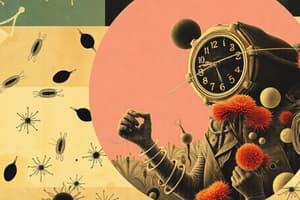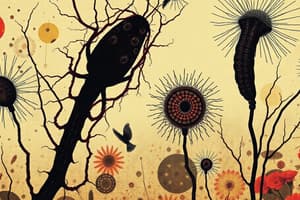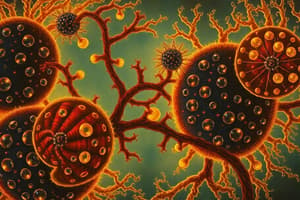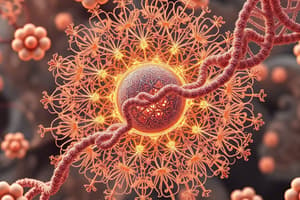Podcast
Questions and Answers
Which functional group contains a carbon atom double-bonded to an oxygen atom and also bonded to a hydroxyl group?
Which functional group contains a carbon atom double-bonded to an oxygen atom and also bonded to a hydroxyl group?
- Phosphate group
- Carboxyl group (correct)
- Hydroxyl group
- Methyl group
Which of the following describes the process where proteins lose their structure and function due to factors like heat or pH changes?
Which of the following describes the process where proteins lose their structure and function due to factors like heat or pH changes?
- Translation
- Hydrolysis
- Denaturation (correct)
- Transcription
Which of the following best describes the role of a 'pseudogene'?
Which of the following best describes the role of a 'pseudogene'?
- An enzyme that cuts DNA at specific locations
- A DNA sequence that has been mutated and no longer functions as a gene (correct)
- Codes for essential proteins after transcription
- A DNA sequence that can move to different locations within the genome
During DNA extraction, which reagent is used specifically to precipitate DNA out of solution?
During DNA extraction, which reagent is used specifically to precipitate DNA out of solution?
If a DNA molecule contains 20% adenine, what percentage of cytosine should it contain?
If a DNA molecule contains 20% adenine, what percentage of cytosine should it contain?
During cellular respiration, ATP is used as an energy source. How does ATP release this energy?
During cellular respiration, ATP is used as an energy source. How does ATP release this energy?
Which characteristic primarily differentiates purines from pyrimidines in terms of their molecular structure?
Which characteristic primarily differentiates purines from pyrimidines in terms of their molecular structure?
Which of the following is a key difference between DNA and RNA in terms of their function?
Which of the following is a key difference between DNA and RNA in terms of their function?
What type of bond connects nucleotides together in a single strand of DNA or RNA?
What type of bond connects nucleotides together in a single strand of DNA or RNA?
If a scientist is studying the region of DNA where proteins bind to initiate transcription, what DNA region are they investigating?
If a scientist is studying the region of DNA where proteins bind to initiate transcription, what DNA region are they investigating?
Flashcards
Buccal Cells
Buccal Cells
Cells inside your cheek.
Carboxyl Group
Carboxyl Group
Functional group with carbon double-bonded to oxygen and bonded to a hydroxyl group.
Cell Membrane
Cell Membrane
Membrane controlling what enters and exits a cell.
Dehydration Synthesis
Dehydration Synthesis
Signup and view all the flashcards
Denaturation
Denaturation
Signup and view all the flashcards
DNA Extraction
DNA Extraction
Signup and view all the flashcards
DNase
DNase
Signup and view all the flashcards
Eukaryote
Eukaryote
Signup and view all the flashcards
Exon
Exon
Signup and view all the flashcards
Hydrolysis
Hydrolysis
Signup and view all the flashcards
Study Notes
Vocabulary
- Buccal cells are cells inside your cheek.
- A carboxyl group is a functional group containing a carbon atom double-bonded to an oxygen atom and also bonded to a hydroxyl group.
- The cell membrane controls what goes in and out of a cell.
- Dehydration synthesis joins two molecules together.
- Denaturation is protein breaking down, losing shape and function due to heat, pH changes, or other factors.
- DNA extraction is the process of isolating and extracting DNA from something.
- DNase is an enzyme that breaks down DNA.
- A eukaryote can be either unicellular or multicellular and has a nucleus and membrane-bound organelles.
- An exon is a segment of a DNA or RNA molecule containing information coding for a protein.
- Hydrolysis breaks up a molecule.
- A hydroxyl group is a functional group.
- An intron is a noncoding DNA sequence.
- Membrane receptors are proteins that bind to molecules outside the cell and transmit signals inside the cell.
- A methyl group is a small molecule made of one carbon and three hydrogen atoms.
- Mitochondria is the powerhouse of the cell.
- A monomer is a small molecule that bonds with other monomers to form larger structures called polymers.
- Pentose is a five-carbon sugar molecule.
- A phosphate group is a functional group consisting of phosphorus and oxygen atoms that plays a role in energy transfer (ATP) and forms part of nucleotides.
- A phosphodiester bond is a covalent bond that joins nucleotides together to form the backbone of DNA and RNA.
- A prokaryote is unicellular, has no nucleus, and no specialized organelles.
- A promoter is a region of DNA where proteins bind to initiate transcription of that gene.
- Protease is an enzyme that breaks down proteins.
- A pseudogene is a DNA sequence that looks like a gene but has been mutated, so it doesn't work anymore.
- A restriction enzyme cuts up DNA at specific sections.
- Transcription is DNA to RNA.
- Translation is RNA to protein synthesis.
- A transposon is a DNA sequence that can move to different locations within the genome.
Nucleic Acids
- The five elements in nucleic acids are carbon, hydrogen, oxygen, nitrogen, and phosphorus.
- DNA nitrogenous bases: thymine, adenine, cytosine, guanine
- RNA nitrogenous bases: uracil, adenine, cytosine, guanine
- Purines are adenine and guanine.
- Pyrimidines are cytosine, thymine, and uracil.
- Purines have a double ring structure while pyrimidines have one ring.
DNA vs RNA
- DNA nucleotide bases: adenine, thymine, guanine, cytosine
- RNA nucleotide bases: adenine, uracil, guanine, cytosine
- DNA sugar: deoxyribose
- RNA sugar: ribose
- DNA is more stable
- RNA is less stable
- DNA structure: double helix
- RNA structure: single-stranded
- DNA function: genetic information
- RNA function: codes for proteins
- DNA location: nucleus
- RNA location: cytoplasm
- DNA relative size: bigger
- RNA relative size: smaller
- ATP provides energy instead of carrying genetic information and has three phosphate groups.
- The monomer of nucleic acids is a nucleotide.
- A nucleotide is a monomer; a nucleic acid is a chain of nucleotides.
- The monomer of nucleic acids is a nucleotide.
- The process of building nucleic acids is dehydration synthesis.
- Dehydration synthesis forms water.
- Dehydration synthesis forms 1 water molecule for every 2 monomers.
- The process that breaks down nucleic acids is hydrolysis.
- Hydrolysis requires water.
- Hydrolysis requires 1 water molecule per bond broken.
- DNA's charge is negative.
- The phosphate backbone gives DNA its negative charge.
- The function of ATP is to provide energy.
- ATP provides energy for cellular respiration, breaking off one of its phosphate groups, turning it into ADP.
- Hydrogen bonds bind complementary nitrogenous bases together.
- A phosphodiester bond holds adjacent nucleotides together.
DNA Extraction Lab
- The basic unit of life is cells.
- DNA extraction aims to isolate, analyze, and compare DNA between organisms to learn about them.
- Basic steps to extract DNA from fruit:
- Grind up the fruit
- Add extraction buffer
- Filter the mixture
- Add cold isopropyl
- DNA extraction from buccal cells involves spitting, adding dish soap, contact lens solution, and salt, then mixing it together and pouring cold isopropyl down the side of the tube.
DNA Extraction Reagents
- Dish soap breaks open cells.
- Salt breaks open the cell membrane to release DNA.
- Alcohol precipitates out the DNA.
- Contact lens solution reduces the amount of protein that precipitates out with the DNA.
- Red blood cells are unique because they don't have a nucleus.
Cellular DNA Protection
- Eukaryotes protect their DNA via the nucleus.
- Prokaryotes use restriction-modification, where specific enzymes "tag" their own DNA, allowing it to be distinguished from foreign DNA.
- Alcohol addition to the filtered fruit/extraction buffer mixture results in different layers:
- The bottom layer contains fruit and extraction buffer
- The middle layer has a cloudy white substance, the DNA
- The top layer is alcohol with a lower density
Studying That Suits You
Use AI to generate personalized quizzes and flashcards to suit your learning preferences.




